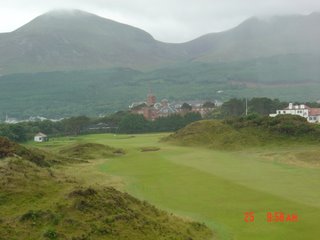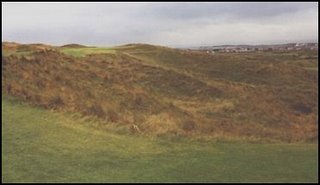Does your view of Northern Ireland still include images of IRA bombings, British Troops riding around in personnel carriers and a dangerous capital city - Belfast?
Our experience in Northern Ireland has been the opposite of the perceived image. When I tell people that I'm going on a golf trip to Northern Ireland I still get a disapproving look that says "are you mad?" When I tell them that it is a beautiful and scenic place with people that are naturally gregarious and friendly they still don't believe.
There are six top 100 golf courses in Ireland - Ballybunion and Lahinch on the West Coast, Portmarnock and The European Club on the East Coast and Royal County Down and Royal Portrush in Northern Ireland. While some courses come and go from the world top 100, the two in Northern Ireland have remained quietly in their appropriate place on the list since its inception. They are always solidly in the top 25 -- usually in the top 15.
Our experience in Northern Ireland has been the opposite of the perceived image. When I tell people that I'm going on a golf trip to Northern Ireland I still get a disapproving look that says "are you mad?" When I tell them that it is a beautiful and scenic place with people that are naturally gregarious and friendly they still don't believe.
There are six top 100 golf courses in Ireland - Ballybunion and Lahinch on the West Coast, Portmarnock and The European Club on the East Coast and Royal County Down and Royal Portrush in Northern Ireland. While some courses come and go from the world top 100, the two in Northern Ireland have remained quietly in their appropriate place on the list since its inception. They are always solidly in the top 25 -- usually in the top 15.
A small minority of courses located in the (former) British Empire have a "Royal" designation in front of their name. This means a member of the Royal family bestowed it upon the club, often times, if they were a member. Both the gems in Northern Ireland have Royal patronage. County Down received its patronage in 1885 and Prince Andrew is the current Royal Patron. Portrush became Royal in 1892 when The Price of Wales bestowed his patronage. The club logos at the beginning of this post, both topped with crowns, are two of the sharpest in golf.

Although located in the same geographic location, the courses have two different personalities. Royal County Down (ranked #10 in the world) is blessed with natural beauty that ranks it among the best in the world for sure. As a backdrop, there are the impressive Mourne mountains which rise up several miles inland and frame the entire area around the course. The course is located on the Irish Sea right next to a lovely beach. Finally, the heather and gorse on the course add to the scenic beauty, but make it quite difficult. If you have the opportunity to play the course when the gorse is in bloom in the Spring, do so. The pictures above and below show the mountains by the sea at County Down.


I have written before that walking up the 9th fairway at Royal County Down is among the most satisfying experiences in golf. Not only do you have a full spectrum of color in all directions, the church steeple rising above the town of Newcastle is on the horizon; the sea is on your left; and the quaint white clubhouse sits in front of you.
The clubhouse at Royal County Down is an understated affair that appropriately befits its Royal patronage. For an American, I always find it quaint to see a picture of the Queen, hanging out of respect. At County Down it is hanging in the bar area that overlooks the course.
Royal County Down was originally designed by Old Tom Morris and was revised by Harry Vardon and still has an old world feel to it. The front nine is the better of the two nines. The back has a weak finish, especially the 17th which is completely out of character with the rest of the course. Imagine how good the rest of the course must be if it ranks this high in the world with 3-4 weak holes. There are many holes on the course where you must hit the ball straight and 200+ yards to carry either a green or a fairway. The 4th hole, a par 3 is one of the most intimidating tee shots you will ever face on a one shot hole. You must hit the ball about 200 yards over a sea of dense gorse. Being short is not an option, since gorse bushes have prickly branches that make retrieving a ball impossible.
There are a couple of blind tee shots where you have to aim over a colored stone placed on a hill. Personally, I like blind shots and for those who think they have no place in golf, I would comment that many courses on the top 100 list have blind shots - including some of the best: Pine Valley, The National Golf Links, Lahinch, Cruden Bay and Muirfield.
There are a couple of blind tee shots where you have to aim over a colored stone placed on a hill. Personally, I like blind shots and for those who think they have no place in golf, I would comment that many courses on the top 100 list have blind shots - including some of the best: Pine Valley, The National Golf Links, Lahinch, Cruden Bay and Muirfield.
If you're not on your game at Royal County Down it will be painful. I have played Royal County Down twice - once in 'fine' conditions as the locals call it and the second time in windy, rainy and cold conditions (in July). Even in miserable conditions it is easy to see that it is a great golf course. I enjoyed both rounds immensely. It is one of the toughest championship links at 7,167 yards from the tips.
Located in County Antrim not far from the Bushmills distillery is The Royal Portrush Golf Club (ranked #12 in the world). The course has been changed several times since its inception, most recently by H.S. Colt. Colt is unquestionably one of the finest architects who ever lived and I personally rank this as his finest effort ahead of Muirfield, Sunningdale and Wentworth (Pine Valley excepted since he only influenced the work of Crump). Along with Carnoustie and Pine Valley it is one of the most imaginative routings in the world. It has a good variety of holes and is challenging.
Portrush hosted the 1951 Open Championship and is worth of hosting one again. Like Royal County Down it does feature a weak finish but again makes up for it on the first 16 holes. The aptly named "Calamity" hole is a demanding par 3 where a sliced ball disappears into a chasm. Look closely at the image below and you can see the green faintly in the distance to the left. The picture is from the tee.

Located in County Antrim not far from the Bushmills distillery is The Royal Portrush Golf Club (ranked #12 in the world). The course has been changed several times since its inception, most recently by H.S. Colt. Colt is unquestionably one of the finest architects who ever lived and I personally rank this as his finest effort ahead of Muirfield, Sunningdale and Wentworth (Pine Valley excepted since he only influenced the work of Crump). Along with Carnoustie and Pine Valley it is one of the most imaginative routings in the world. It has a good variety of holes and is challenging.
Portrush hosted the 1951 Open Championship and is worth of hosting one again. Like Royal County Down it does feature a weak finish but again makes up for it on the first 16 holes. The aptly named "Calamity" hole is a demanding par 3 where a sliced ball disappears into a chasm. Look closely at the image below and you can see the green faintly in the distance to the left. The picture is from the tee.

I always advocate taking a caddie for any round of golf if they are available. I especially like caddies in Ireland and Scotland for their wit, humor, wisdom, perspective and charm.
The last time I played Royal Portrush I had a world-class caddie. On one approach shot to the green he told me to hit the ball 150 yards. I was thinking maybe play it an extra 10 yards longer and asked "what if I hit it 160?" His answer I remember to this day - "There's no flag at 160!". This perfectly sums up the best of Irish caddies. They may not be Oxford educated but they have tons of wisdom and dispense it succinctly. If I played with him all the time, I'm sure my handicap would be five points lower.
Each hole at Portrush has a name, and you can only imagine what playing the hole called "Purgatory" is like.There are several holes at Portrush that border on the Irish Sea along the famous Causeway Coastline. The coastline is dramatic and falls away quickly to the sea creating some stunning views. They are nicknamed "The White Rocks" due to their color.
I first visited Northern Ireland in September 1998, not long after the deadly Omagh bombings. Never-the-less, the country did not have a police-state feel to it. There were no border crossing checkpoints or obvious problems. The only noticeable differences to the South are better roads in the North and the police stations look like fortified bunkers with barbed wire. Today, you will still see an occasional IRA or Protestant mural painted on the side of a building. Otherwise, the reality is it's very much like the Irish Republic to the south from a golfers standpoint.
My hope is that both courses remain forever in the top 15 in the world rankings where they belong.
My hope is that both courses remain forever in the top 15 in the world rankings where they belong.


Tidak ada komentar:
Posting Komentar